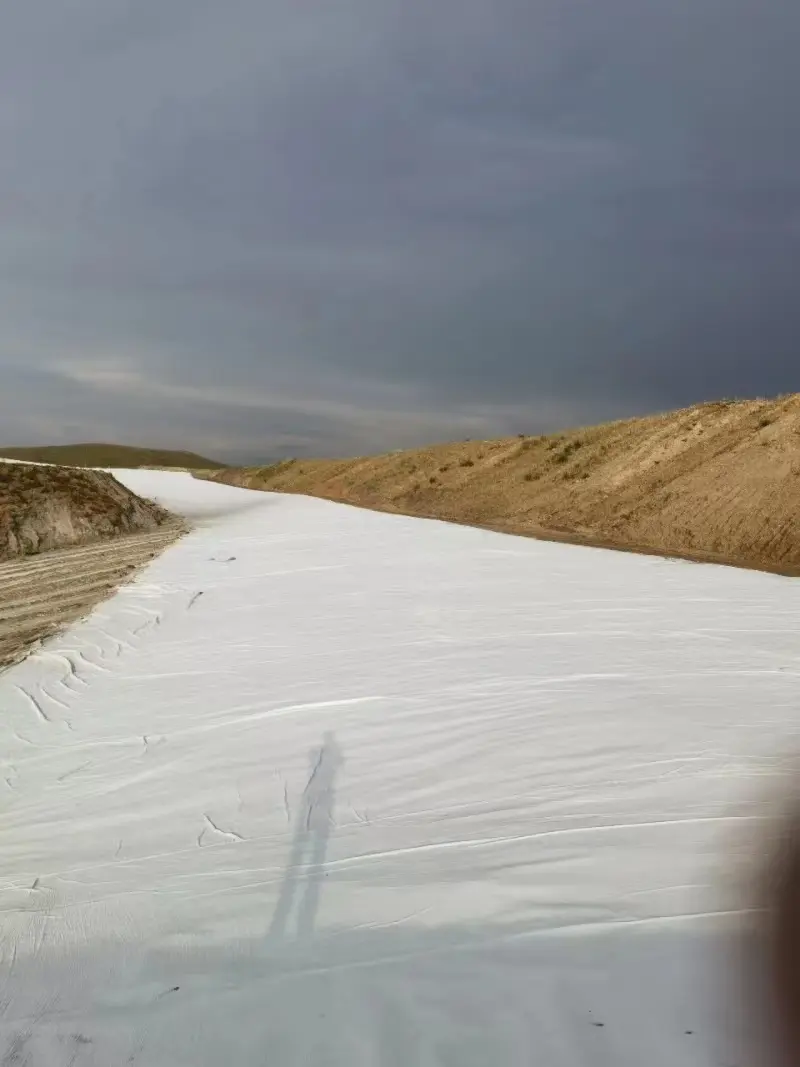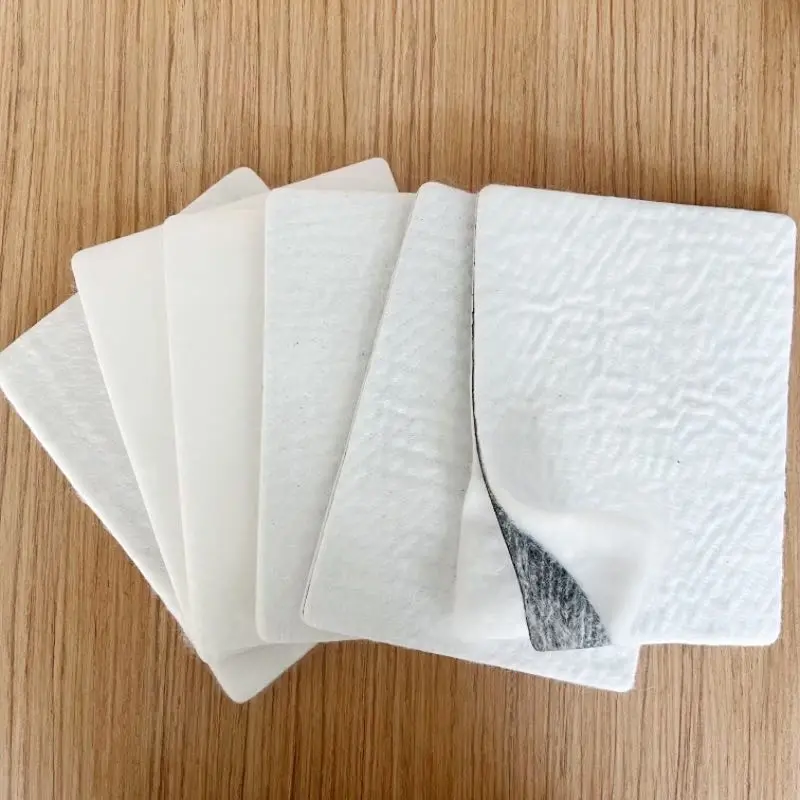What is Composite Geotextile Membrane?
952069.webp)
Composite Geotextile Membrane is a type of geotechnical material used for waterproofing in various engineering projects. It is composed of two or more different layers of materials, typically including geofilm layers and geofabric layers. These layers are bonded together to create a durable and impermeable barrier that prevents the passage of water and other liquids. Composite Geotextile Membrane are commonly used in applications such as landfill liners, pond liners, containment barriers, and canal linings, where waterproofing and environmental protection are critical. The installation process involves careful planning and execution to ensure optimal product properties and performance.
Product Properties
Some common properties of composite geotextile membrane include:
1, Waterproofing: Composite geotextile membrane provide excellent waterproofing properties, forming a barrier to prevent the passage of water and other liquids.
2, Chemical Resistance: They often exhibit resistance to a wide range of chemicals found in soil, groundwater, and industrial environments, protecting underlying structures from corrosion and degradation.
3, Strength and Durability: Composite geotextile membrane are designed to withstand mechanical stresses such as punctures, tears, and abrasion, ensuring long-term performance in demanding conditions.
4, Flexibility: They typically have good flexibility and conformability to uneven surfaces, allowing for ease of installation and adaptation to various project requirements.
5, UV Resistance: Many composite geotextile membrane are formulated with additives to provide UV resistance, ensuring prolonged exposure to sunlight without significant degradation.
Overall, composite geotextile membrane offer a combination of properties that make them suitable for a wide range of geotechnical and environmental applications requiring reliable waterproofing and containment solutions. Proper installation of composite geomembrane is crucial in engineering construction. Next let's discuss how to install composite geotextile membrane.
How to Install Composite Geotextile Membrane?

During construction of composite geotextile membrane, it is essential to strictly adhere to the specifications for the correct laying and fixing of geotextile membranes to ensure their integrity and effectiveness, thereby enhancing the safety and reliability of the project.
Foundation (Support Layer)
1.The foundation must be uniformly and compactly consolidated, with a dry density of no less than 1.4 t/m3 for soil foundations. The uniformity error should not exceed 10%.
2. For soil bases influenced by groundwater, it is advisable to lay a 2cm sand layer or a layer of non-woven fabric on a smooth foundation.
3.For soil bases not influenced by groundwater, after removing surface roots and other debris that may puncture the geotextile membrane, direct placement is allowed. However, "reverse valve" or sub-membrane ventilation and drainage measures are required.
4. An anchor trench should be established at the upper end for stabilization.
Installation of Composite Geotextile Membrane
1,One Fabric-One Membrane Seam Connection
1) Membrane Heat Welding, Membrane Fabric, Fabric Fabric KS Adhesive Bonding (2) Membrane Membrane, Membrane Fabric, Fabric Fabric KS Adhesive Bonding
3)KS Membrane Adhesive Bonding
2. Two Fabrics-One Membrane Seam Connection
1) Membrane Heat Welding, Membrane Fabric, Fabric Fabric KS Adhesive Bonding
2)Membrane Membrane, Membrane Fabric, Fabric Fabric KS Adhesive Bonding
Construction Process Principles and Procedure
1. Principles of Composite Geotextile Membrane Construction:
Composite geotextile membrane is a type of geotechnical synthetic material known for its effective waterproofing capabilities. It is laid on slopes that require waterproofing treatment. A sand cushion layer and concrete are placed on top, forming a completely sealed waterproofing system.
2. Construction Process Procedure for Composite Geotextile Membrane:
Prior to the installation of the composite geotextile membrane, the earthwork filling in the channel and slope surface must be completed. The slope surface should meet the design requirements for smoothness and compaction, as verified and approved by the supervising engineer. Only after meeting these conditions can the installation of the composite geotextile membrane proceed.
Construction Method
1、 Construction Preparation
1) Quality Inspection of Composite Geotextile Material: The composite geotextile used in this project is a two-fabric-one-membrane composite geotextile produced by Shandong Taifeng Plastic Geotechnical Material Co., Ltd. Before use, the product undergoes quality testing for various technical indicators at the Heilongjiang Provincial Water Conservancy Engineering Quality Testing Center. All indicators meet standard specifications and design requirements.
2) Cleaning and Leveling of Embankment Slopes: Clean and level the embankment slopes, removing all sharp objects. Backfill and compact the underfilled slopes, and after cutting and leveling, undergo acceptance by the supervising engineer. Once approved, it provides a working surface for laying the composite geotextile.
3) Joining of Geotextile Sheets in the Field: To facilitate construction and ensure joint quality, the composite geotextile should preferably be of a wide width to minimize on-site joining. Before construction, cut the geotextile according to the required width and length for the site. Join the cut pieces to form blocks that meet the specified dimensions, roll them onto steel pipes, and manually transport them to the work surface for installation.
2、Installation of Composite Geotextile Membrane
1) Installation Method of Composite Geotextile: The installation of the composite geotextile consists of two parts: channel bottom installation and slope surface installation. The installation method involves horizontal rolling along the channel axis direction. For slope surface installation, after the slope is accepted as qualified, rolling is carried out along the axis direction. The connection between the composite geotextiles on the slope and the channel bottom uses a T-shaped connection.
2) Technical Requirements for Composite Geotextile Installation: Installation should take place in dry and warm weather conditions. To facilitate joining and prevent stress concentration, a wavy and loose laying method is employed with an excess of approximately 1.5%. After spreading, promptly flatten and stretch the geotextile. It is required that the composite geotextile aligns smoothly with the slope surface, free from protrusions or wrinkles. Construction personnel should wear flat-soled or soft rubber shoes and are strictly prohibited from wearing spiked shoes to avoid damaging the geotextile. If any damage is discovered during construction, it should be promptly repaired.
3、Joining of Composite Geotextile Membrane
1) When use a two-fabric-one-membrane composite geotextile, and welding is performed using the hot-melt welding method. Joining includes stitching of geotextile fabric and welding of the geotextile membrane. To ensure welding quality, welding should ideally be done in the factory. However, due to construction convenience, on-site joining is necessary.
2) The quality of welding for the composite geotextile is crucial for the success of its waterproofing performance. Therefore, special attention must be given to the welding process to ensure quality. The welding of geotextile should be conducted by professional technicians dispatched by the manufacturing company, providing guidance, training, and utilizing specialized welding equipment. In this project, a ZPR-210V hot-air welding machine is used for geotextile membrane welding, and a portable bag-sealing machine is used for geotextile fabric stitching.
3) After laying the first geotextile membrane, fold the edges to be welded (approximately 60cm wide). Lay the second membrane in the reverse direction on top of the first membrane, adjusting the alignment of the edges for a 10cm overlap.
4)Use a hairdryer to blow away sand, dirt, and other impurities from the membrane surface to ensure cleanliness. Place a long wooden board underneath the welding area for the welding machine to move smoothly on a flat surface, ensuring welding quality. Before the official welding, conduct a trial weld based on the construction temperature to determine walking speed and welding temperature. Generally, maintain a walking speed of 1.5 to 2.5 m/s, with a welding temperature between 220 to 300°C. Create two welding seams, each 10mm wide, leaving a 10mm gap between the two seams. Inspect the quality of the weld in this gap.
4、Anchoring of Composite Geotextile Membrane: The upper anchoring of the composite geotextile membrane is achieved by embedding a sufficient length of the geotextile membrane at the top of the embankment, forming a concrete capping board.
5、Cushion Layer and Concrete Protection: A uniform 10cm sand cushion layer is evenly laid on top of the composite geotextile membrane. After leveling and compacting, a 10cm concrete layer is applied. For slope surfaces where the installation of the composite geotextile membrane is deemed successful, a cushion layer should be promptly laid to cover and protect it from wind exposure and aging due to sunlight. Additionally, proper concrete protection measures should be implemented to enhance the overall protection of the composite geotextile membrane.
Always refer to the specific guidelines provided by the manufacturer of the composite geotextile membrane, as installation procedures can vary based on the type of material and intended application. Additionally, consulting with a geotechnical engineer or installation expert can help ensure the proper execution of the installation process.

897.webp)
942.webp)
237.webp)